|
||||||||||||||||||||||
![Home - Air Power Australia Website [Click for more ...]](APA/APA-Title-NOTAM.png) |
||||||||||||||||||||||
![Sukhoi PAK-FA and Flanker Index Page [Click for more ...]](APA/flanker.png) |
![F-35 Joint Strike Fighter Index Page [Click for more ...]](APA/jsf.png) |
![Weapons Technology Index Page [Click for more ...]](APA/weps.png) |
![News and Media Related Material Index Page [Click for more ...]](APA/media.png) |
|||||||||||||||||||
![Surface to Air Missile Systems / Integrated Air Defence Systems Index Page [Click for more ...]](APA/sams-iads.png) |
![Ballistic Missiles and Missile Defence Page [Click for more ...]](APA/msls-bmd.png) |
![Air Power and National Military Strategy Index Page [Click for more ...]](APA/strategy.png) |
![Military Aviation Historical Topics Index Page [Click for more ...]](APA/history.png)
|
![Intelligence, Surveillance and Reconnaissance and Network Centric Warfare Index Page [Click for more ...]](APA/isr-ncw.png) |
![Information Warfare / Operations and Electronic Warfare Index Page [Click for more ...]](APA/iw.png) |
![Systems and Basic Technology Index Page [Click for more ...]](APA/technology.png) |
![Related Links Index Page [Click for more ...]](APA/links.png) |
|||||||||||||||
![Homepage of Australia's First Online Journal Covering Air Power Issues (ISSN 1832-2433) [Click for more ...]](APA/apa-analyses.png) |
|
|||||||||||||||||||||
| Last Updated: Mon Jan 27 11:18:09 UTC 2014 | ||||||||||||||||||||||
|
||||||||||||||||||||||
|
||||||||||||||||||||||
![Home - Air Power Australia Website [Click for more ...]](APA/APA-Title-NOTAM.png) |
||||||||||||||||||||||
![Sukhoi PAK-FA and Flanker Index Page [Click for more ...]](APA/flanker.png) |
![F-35 Joint Strike Fighter Index Page [Click for more ...]](APA/jsf.png) |
![Weapons Technology Index Page [Click for more ...]](APA/weps.png) |
![News and Media Related Material Index Page [Click for more ...]](APA/media.png) |
|||||||||||||||||||
![Surface to Air Missile Systems / Integrated Air Defence Systems Index Page [Click for more ...]](APA/sams-iads.png) |
![Ballistic Missiles and Missile Defence Page [Click for more ...]](APA/msls-bmd.png) |
![Air Power and National Military Strategy Index Page [Click for more ...]](APA/strategy.png) |
![Military Aviation Historical Topics Index Page [Click for more ...]](APA/history.png)
|
![Intelligence, Surveillance and Reconnaissance and Network Centric Warfare Index Page [Click for more ...]](APA/isr-ncw.png) |
![Information Warfare / Operations and Electronic Warfare Index Page [Click for more ...]](APA/iw.png) |
![Systems and Basic Technology Index Page [Click for more ...]](APA/technology.png) |
![Related Links Index Page [Click for more ...]](APA/links.png) |
|||||||||||||||
![Homepage of Australia's First Online Journal Covering Air Power Issues (ISSN 1832-2433) [Click for more ...]](APA/apa-analyses.png) |
|
|||||||||||||||||||||
| Last Updated: Mon Jan 27 11:18:09 UTC 2014 | ||||||||||||||||||||||
|
||||||||||||||||||||||
How? The Deadly Question
for the F-35 Joint Strike Fighter
|
|||||||||
|
Air Power
Australia - Australia's Independent Defence Think Tank
|
|||||||||
| Air Power Australia NOTAM 5th July, 2010 © 2010 C. L. Mills |
|||||||||
|
|||||||||
|
|||||||||
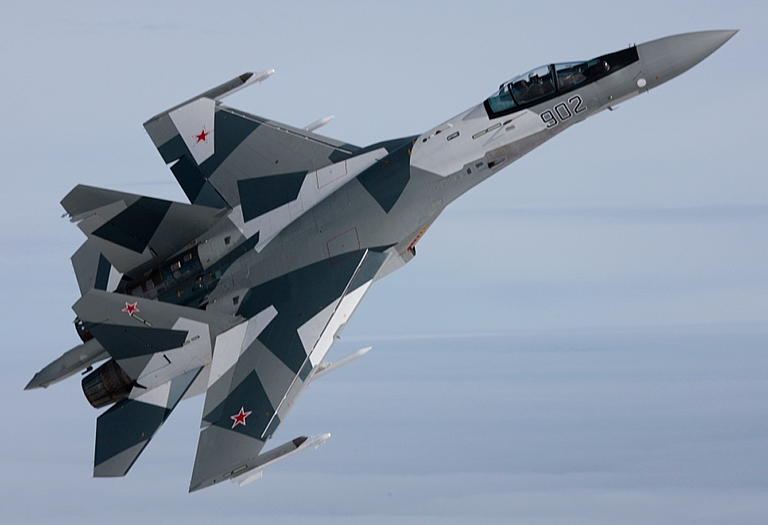 The
depicted
Su-35S
is
expected
to
be
the last
Flanker variant to be mass produced before the PAK-FA enters full rate
production (KnAAPO image).
|
|||||||||
| How
will the intended 2,443 F-35s JSF impose air dominance for the USA
and its Allies? That is the question to ask. Search the Internet for material on the JSF and you will find terabyte after terabyte of articles, pictures, Powerpoint presentations, PDFs, tables and laudatory Blogs. And how much relates to how the JSF will deliver this capability? You will find assertions and statement such as ‘six times better Relative Loss Exchange Ratio than legacy aircraft’ [1], or ‘The operational arguments focus on combat effectiveness against top foreign fighter aircraft such as the Russian Su-27 and MiG-29. Lockheed Martin and USAF analysts put the loss-exchange ratio at 30-1 for the F-22, 3-1 for the F-35 and 1-1 or less for the F-15, F/A-18 and F-16’[2]. And how will the F-35 JSF perform, not against truly obsolete legacy aircraft like the Su-27SK and the MiG-29, but against modern fighters like the Su-35S? We can answer these questions with a head-to-head analysis of the two aircraft. Air combat is a complex mix of art, science and engineering. Aircraft performance, weapons performance, networked sensors and pilot skill all contribute to the final Loss Exchange Ratio (LER). The only simplification is that aircraft approach, engage in combat and the survivors depart. This activity can be examined in a ‘kill-chain’ with the following stages: ‘Detect-Identify-Engage-Disengage-Destroy’ (DIED2). Here is a scenario. In the ‘Blue’ corner, we have a flight of four F-35A JSFs, each armed with four AIM-120D Beyond Visual Range (BVR) missiles and the 25 mm GD ATP GAU-22/A cannon. No additional weapons or fuel are carried, because these would compromise the JSFs' “low observability” to X-Band radar. In the ‘Red’ corner, we have a flight of four Su-35S, each armed with four RVV-SD Active Radar Seeker BVR Missiles, four RVV-SD Infra-Red (IR) Seeker BVR missiles, two RVV-MD Within Visual Range (WVR) missiles, the 30mm GSh-301 cannon, KNIRTI SAP-518 jammers on the wingtips and a 6,000 litre conformal tank between the engines. Each aircraft has the full range of sensors and countermeasures. Here is a table to show how they compare: |
|||||||||
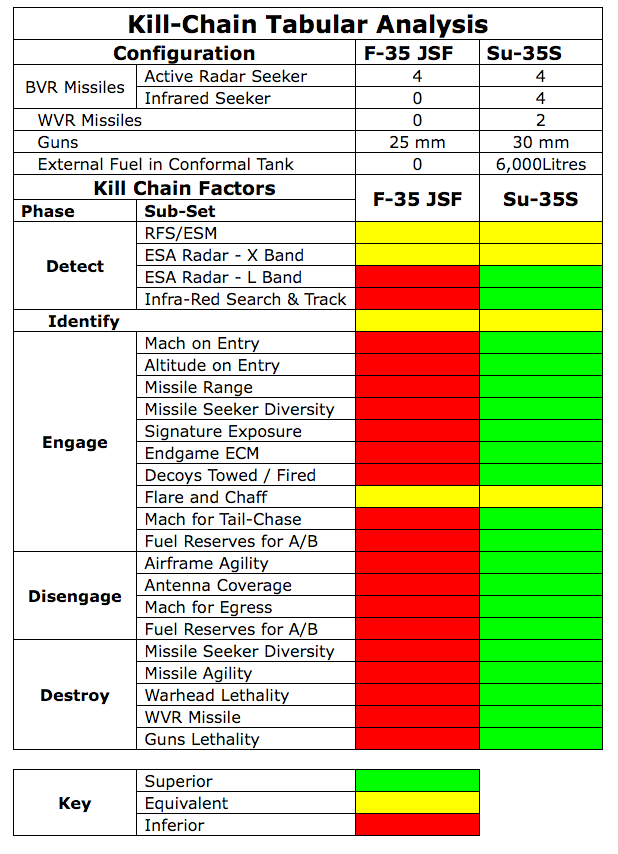 |
|||||||||
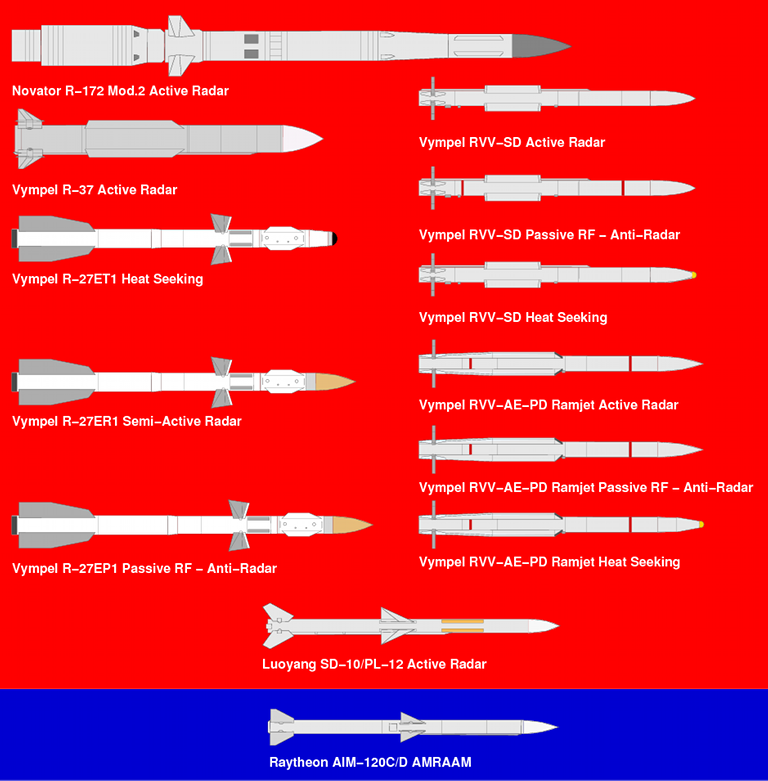 Figure
1:
Diversity
in
missile
airframes and seekers. A Western pilot must be
proficient in evasion tactics for no less than six different families
of BVR missile airframes, and four different categories of missile
seeker. The endgame radiofrequency and optical countermeasures suites
in a Western airframe must be effective against seven different
families of missile seeker, including variants thereof. A pilot flying
a Russian or Chinese supplied fighter only needs tactics and technology
to defeat the AIM-120B/C/D AMRAAM. Not included is the R-27AE Alamo
with a digital variant of the RVV-SD active radar terminal seeker
(Diagram © 2010 Dr Carlo Kopp).
|
|||||||||
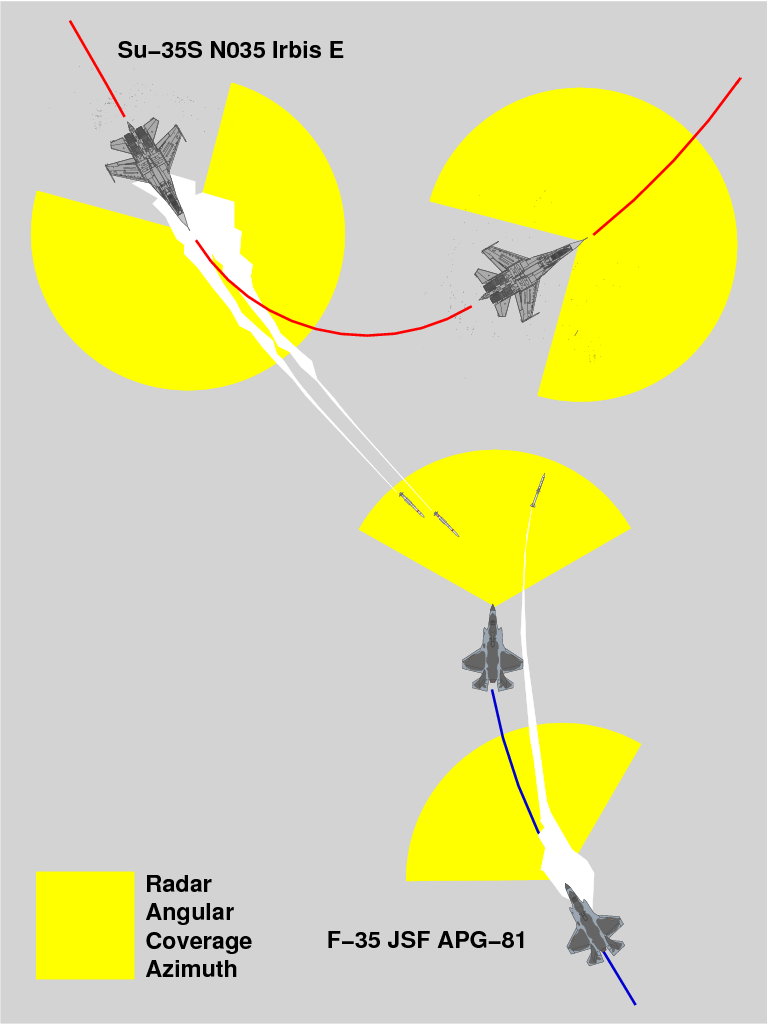 Figure
2:
A
key
problem for the F-35 family of aircraft is that genuine X/S-band
low observability is only achieved in a relatively narrow angular
sector around the nose of the aircraft. This forces the aircraft to ‘point it's nose’ at the highest threat,
denying flexibility in prosecuting a missile shot, or evading multiple
threats. The absence of cheek and aft radar arrays exacerbates the
problem, and cannot be fixed given the weight, power and cooling
problems in the basic airframe design (Diagram ©
2010 Dr Carlo Kopp).
|
|||||||||
Whoa! The F-35A assessments are all marked in Red and Yellow – Inferior or Equivalent. Why is that? Let’s look at each element of the ‘kill-chain’. Detect: Electronic Support Measures: Air combat aircraft emit radiation from jet engines, radar, JTIS/MIDSs terminal, radio transmissions. Specialised equipment in combat aircraft knows the frequencies of these transmissions and has sensors to detect them. Attempts are made to minimise emissions through a process of ‘Emission Control’ (EMCON) but these can only be partially successful. Both the JSF and the Su-35S have a full range of these sensors, and are assessed as being equally effective in ESM capability. ESA Radar X-Band: This is the primary sensor for jet fighters. The radar cross section of the F-35A is substantially lower than that of the Su-35S especially in the front sector, but the Sukhoi has sufficient power and a much larger antenna to partially overcome that difference. Both types are ‘networked’ so in a multi-ship engagement, the geometrical spread of the Su-35S flight in part negates the lower observability of the JSF by illuminating the JSF from angles where its low observability is weakest. Expect the F-35A to often get the ‘first look’, but the Su-35S flight to detect the JSF outside the range of the JSFs' BVR missiles. So where it matters, the limited low observability of the JSF provides little advantage. ESA Radar L-Band: The Su-35S will have this lower-frequency radar in its wing leading edges. The JSF is ‘stealthed’ for X-Band, not for L-Band. While the antenna size of the Su-35S L-Band radar limits its performance, there will be times when the L-Band radar detects the JSF before the X-Band radar. The JSF does not have an L-Band Radar and is assessed accordingly. Infra-Red Search & Track: There is a different approach to Infra-Red sensors. The JSF has a superb Electro-Optical Distributed Aperture System (DAS) designed to cover the sphere around the aircraft, but strongly optimised for air-to-ground operations. The Su-35S has a large aperture OLS-35 IRST optimised to scan for other aircraft at long range in its area of interest. DAS is a ‘staring array’ while the OLS-35 is a ‘scanning array’. The difference in detection range is like the difference between a person searching with a naked eye compared with another searching with a telescope. If the telescope is pointed in the right direction, it will get first detection. Add to that the factor that the JSF has the hottest engine in the market, and the IRST of the Su-35S is assessed as a superior aid to air combat. Identification: Not much need to be said here. The threat of fratricide in BVR air combat has led to the development of identification systems that will reliable separate friend from foe. Fratricide still happens though, especially in mixed, close-in fights. Engagement: Mach on Entry: High Mach increases the energy of BVR missiles, sending them further. The design top speed of the Su-35S is 2.25, limited by canopy and radome heating, so it has surplus power and the fuel to burn to sustain high Mach numbers. The drag of the external stores is likely to reduce this to something below Mach 2, but the missiles are cleared for launch at all speeds. The JSF has yet to demonstrate a flight above Mach 1.05, but even if it reaches its design speed of Mach 1.6, it is clearly inferior. Altitude on Entry: Like Mach, a higher altitude adds potential energy to BVR missiles, sending them further, while an enemy’s missiles must ‘climb the hill,’ severely reducing range. A second factor is that missiles fired from a higher altitude have less drag, again increasing range. The JSF is optimised for Strike missions flown at about 15-25,000 feet, while the Su-35S is optimised for air combat missions at about 40,000 feet and above, with a combat ceiling close to 60,000 feet. Points go to the Su-35S on operating altitude. Missile Range: The RVV-SD and the AIM-120D have roughly equivalent ranges, but when the RVV-SD has a high-Mach, high-altitude launch; it will outrange the AIM-120D. The Su-35S is assessed at delivering a longer BVR engagement range. This area of superiority will be increased once the RVV-AE-PD ramjet missile becomes operational. In addition, the Su-35S can carry the very long range R-37 and R-172 missiles, with ranges to 200 nautical miles. Missile Seeker Diversity: The AIM-120D currently has an active radar seeker, while the RVV-SD/R-77ME and the R-77TE have active and infra-Red (IIR) seekers respectively. Mixed sensor seekers complicate defences, for example, the F-35 may turn to defeat an active seeker and expose a hot part of the aircraft to an IR seeker. Russian doctrine is to ‘pair’ missiles with an active seeker followed by a IR seeker, creating diversity in the fight and creating ‘kill’ opportunities. The Russian missiles also have the option of passive anti-radiation seekers, designed to home on X-band radar. This diversity in missile seeker sensors gives an advantage to the Su-35S. Signature Exposure: This is a factor that primarily affects the JSF, known to have a ‘Pacman’ radar cross-section at X-Band, with a Low Observability ‘notch’ at the front. As it manoeuvres, it can turn the notch away from an aircraft searching sensor, and expose a higher radar cross-section to that search, or expose a broadside or rear-side to another aircraft. The F-35 relying on a ‘can’t see me, can’t kill me’ capability, has more to lose in a spread, manoeuvring engagement than the Su-35S, which will generally be detectable by the JSF for most of the engagement. This exposure can occur, for example, when the JSF is guiding a missile and turns away to reduce the closure rate, thereby exposing both the aircraft and an incoming missile to longer range detection, or detection from a widely spaced wingman. As the JSF is reliant on signature reduction for survival, it has more to lose if its signature increases, so is assessed as more vulnerable in the dynamics of a multi-ship, networked, turning engagement where signature management is very difficult. Endgame Electronic Countermeasures (ECM): The ‘modus operandi’ of stealth aircraft is not to radiate, or return radiation, which is the way ECM countermeasures work. Su-35S has ECM, JSF does not, except for intended AESA Radar jamming modes across a limited forward cone of about 120 degrees. ECM based on Digital Radio Frequency Memory (DRFM) can be very effective, especially against missiles with limited processing power and time to resolve targets. The Su-35S also has several ECM modes. The JSF is assessed as inferior, because it does not employ ECM to defeat attack. Decoys Towed / Fired: The Su-35S has the option of deploying towed decoys to lure a closing missile away from the body of the aircraft. The JSF approach is different, with small ‘Gen-X’ active decoys being fired as a missile closes. These measures are assessed as being approximately equivalent, with the towed decoys which are at co-speed to the target likely to present the more effective countermeasure. Flares and Chaff: These are outmoded countermeasures, but still add to the difficulty of guiding a missile to close proximity of an airframe. The GSh-301 is claimed to have rounds that fire chaff forward of the aircraft, so chaff-discrimination processing in a closing missile might be deceived. Nonetheless, the countermeasures are assessed as equivalent. Mach for a Tail-Chase / Fuel Reserves for Afterburner: At some time in a fight, an aircraft has to depart, for example when ‘Winchester’ or out of ammunition, or ‘Bingo’ or down to just enough fuel to get home. Then the fight becomes a tail-chase. The Su-35S with its higher Mach can close on a JSF, the reverse is not the case. The ability of the Su-35S to carry large fuel loads, and the prodigious consumption of the JSF F135 engine in maximum afterburner exacerbates this perilous situation for the JSF. The advantage is with the Su-35S in these aspects of engaging in a fight when the JSF is attempting to disengage. Disengagement: This is one of the under-assessed areas of future air combat. When missiles of roughly equivalent range are fired, they travel for over 100 seconds to the target. This transit time provides an opportunity for countermeasures to defeat the attack. Missile motor launch-flares are intensive and difficult to hide from Infra-Red sensors, so in many engagements, there will be early warning of an incoming missile. Active seekers ‘light-up’ at about 10 nautical miles from the target, still providing valuable warning time. Here is a range of disengagement measures: Airframe Agility: Once warned of a launch, the defending aircraft can sometimes defeat the attack by rapidly turning away to force the missile into a tail-chase. Antenna Coverage: AESA radars like the JSF APG-81 working from a fixed back-plate cover a cone of about 120 degrees. The Su-35S has an ESA radar working from a gimballed ‘swash-plate’ that covers about 240 degrees around the nose, and there is a second radar in the ‘stinger’ albeit with less capability, to cover the remainder of the sphere. If the Su-35S and the JSF fire a BVR missile at the same time and at maximum range, the Su-35S can turn away to about 120 degrees off the line joining the two aircraft, while the JSF is constrained to about 60 degrees. This runs the JSF into the Su-35S’s missile, while the Su-35S is running away from the JSF’s missile. The result could be an RVV-SD hit and an AIM-120 miss. Points to the Su-35S on this aspect. Mach on Egress / Fuel Reserves for Afterburner: This is an extension of the antenna coverage capability, as the Su-35S can accelerate away from the incoming missile, forcing it to drop-short. The JSF does not have this performance and is assessed as inferior. Destroy: Missile Seeker Diversity: At terminal phases of an engagement, there may be several missiles in the vicinity, with aircraft manoeuvring to defeat the attack. An incoming missile with an IR seeker may be presented with the ‘rear end’ of a JSF and track for a kill. This opportunity is not available to the JSF attacking the Su-35S, as its limited missile carriage does not include BVR missiles with IR seekers. Missile Agility: This is the ‘flip side’ of aircraft agility. The R-77 has the famous ‘potato masher’ lattice-tail control surfaces, that while increasing drag over conventional surfaces, also give greater terminal manoeuvring capability. So, the Su-35S BVR weapons can out-turn the F-35’s weapons. Warhead Lethality: This is a mix of warhead destructive power and the vulnerability of the target airframe. The AIM-120D has an 18 Kg, fragmentation warhead, and the Su-35S widely spaced armoured engines, armoured sections of the airframe and redundancy of system. The R-77 missiles have 30 kg expanding-rod warheads to destroy the single-engine JSF, from which critical systems like fire suppression have been removed to reduce weight and cost. The Su-35S is assessed as superior. WVR Missiles: This is as simple as ‘the Su-35S carries WVR missiles, the JSF does not’ (in this example). The JSF can carry WVR missiles, but they are an external mount, impairing radar signatures. Guns Lethality: Bigger is better. 30 mm rounds have more explosive power than 25 mm rounds. Again, the airframe vulnerability is an issue and a single 30 mm hit to the JSF’s single engine could bring it down. At the end of the kill-chain, it seems, prima facie, that the Su-35S has all the ‘right stuff’ for air combat, while the F-35 JSF does not. This should come as no surprise, because the design brief for the JSF was that the F-22A would ‘sanitise’ airspace and deliver air dominance, making it safe for the Joint STRIKE Fighter to deliver follow-up strike capabilities. Now that the F-22A Raptor program is being terminated with insufficient aircraft to deliver air dominance, this role is now being assigned to the F-35 JSF. Given the intent of the OSD to employ the F-35 Joint Strike fighter as an air dominance fighter, the fundamental and unanswered question is:
|
|||||||||
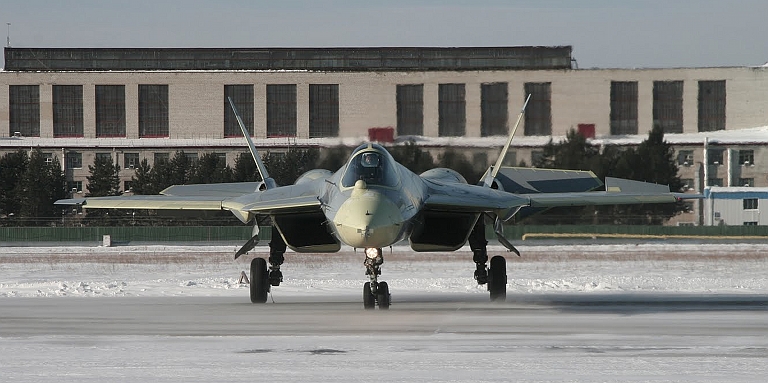 |
|||||||||
 |
|||||||||
Notes |
|||||||||
|
|
|||||||||
| Air
Power
Australia
Website - http://www.ausairpower.net/ Air Power Australia Research and Analysis - http://www.ausairpower.net/research.html |
|||||||||
 |
|||||||||
| |
|||||||||
|
|||||||||||||
![Sukhoi PAK-FA and Flanker Index Page [Click for more ...]](APA/flanker.png) |
![F-35 Joint Strike Fighter Index Page [Click for more ...]](APA/jsf.png) |
![Weapons Technology Index Page [Click for more ...]](APA/weps.png) |
![News and Media Related Material Index Page [Click for more ...]](APA/media.png) |
||||||||||
![Surface to Air Missile Systems / Integrated Air Defence Systems Index Page [Click for more ...]](APA/sams-iads.png) |
![Ballistic Missiles and Missile Defence Page [Click for more ...]](APA/msls-bmd.png) |
![Air Power and National Military Strategy Index Page [Click for more ...]](APA/strategy.png) |
![Military Aviation Historical Topics Index Page [Click for more ...]](APA/history.png)
|
![Information Warfare / Operations and Electronic Warfare Index Page [Click for more ...]](APA/iw.png) |
![Systems and Basic Technology Index Page [Click for more ...]](APA/technology.png) |
![Related Links Index Page [Click for more ...]](APA/links.png) |
|||||||
![Homepage of Australia's First Online Journal Covering Air Power Issues (ISSN 1832-2433) [Click for more ...]](APA/apa-analyses.png) |
|||||||||||||
| Artwork, graphic design, layout and text © 2004 - 2014 Carlo Kopp; Text © 2004 - 2014 Peter Goon; All rights reserved. Recommended browsers. Contact webmaster. Site navigation hints. Current hot topics. | |||||||||||||
|
Site Update
Status:
$Revision: 1.753 $
Site History: Notices
and
Updates / NLA Pandora Archive
|
|||||||||||||
|
|
Tweet | Follow @APA_Updates | |||||||||||
|
|
|||||||||||||
|
|
|||||||||||||